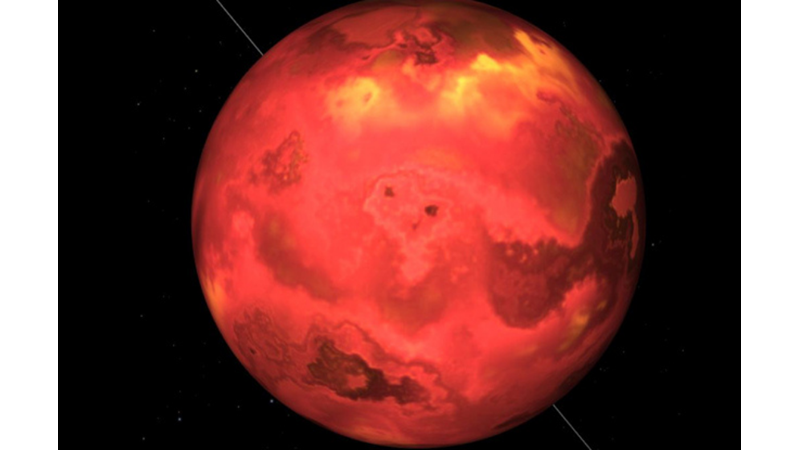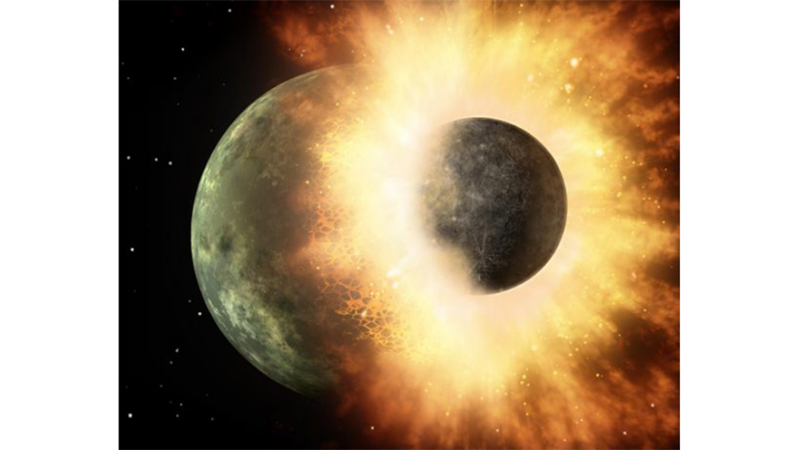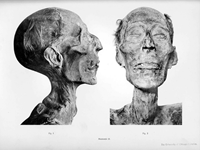We cannot understand nature without understanding its range. This is evident in exoplanet science and in our theories of planet formation. Nature's outliers and quirks put pressure on our models and motivate scientists to dig deeper.
Gliese 367 b (or Tahay) is certainly a strange planet. It is an Ultra Short Period (USP) planet orbiting its star in just 7.7 hours.
There are about 200 other USP planets in our catalogue of more than 5000 exoplanets, so Gliese 367 b is not unique in this respect. But it is also an outlier in another way: it is also an ultra-dense planet. It is almost twice as dense as Earth.
Which means it must be almost pure iron. Elisa Goffo, lead author, University of Turin says:
"You can compare GJ 367 b to an Earth-like planet with its rocky mantle removed."
Astronomers found Tahay in TESS (Transiting Exoplanet Survey Satellite) data from 2021. But new research in The Astrophysical Journal Letters refines the mass and radius of the strange planet with improved measurements. It also found two siblings for the planet.
The research is called "The Company for the Ultra-High-Density, Ultra-Short-Period Sub-Earth GJ 367 b: Discovery of Two Additional Low-Mass Planets in 11.5 and 34 Days." The lead author is Elisa Goffo, a PhD student in the Department of Physics at the University of Turin.
TESS found Gliese 367 b in 2021 when it detected an extremely weak transit signal from a red dwarf star called Gliese 367. The signal was at the limits of TESS' detection capacity, so astronomers knew it was small, like Earth.
As part of their 2021 study, the researchers used the High Accuracy Radial Velocity Planet Searcher (HARPS) spectrograph at the European Southern Observatory to determine the mass and density of G 367 b.
They determined that the planet's radius is 72 per cent of Earth's and its mass is 55 per cent of Earth's. This means that it is probably an iron planet, the core of what was once a much larger planet.
Now to the new research by Goffo and colleagues.
They too used HARPS to measure the small planet. This time they used 367 HARPS observations of G 371 b. These results show that the planet is even denser than found in the 2021 study. Instead of 55 per cent of Earth's mass, this new study reveals that the planet is 63 per cent of Earth's mass. Its radius has also decreased from 72 per cent to 70 per cent of Earth's.
As a result, G 367 b is twice as dense as Earth.
How did the planet get this way? It's unlikely to have formed in its current form. Instead, it is probably the core of a planet with its rocky mantle stripped away.
"You can compare GJ 367 b to an Earth-like planet with its rocky mantle stripped away," said lead author Goffo.
"This could have important implications for the formation of GJ 367 b. We believe the planet may have formed like Earth, with a dense core made mainly of iron, surrounded by a silicate-rich mantle."
Something extraordinary must have happened for the small planet to lose its mantle. "A catastrophic event could have stripped away its rocky mantle, leaving the planet's dense core bare," Goffo explained. Collisions with other protoplanets that were still forming early in its life may have removed the planet's outer layer.
Another possibility, according to Goffo, is that the small USP was born in an unusually iron-rich region of a protoplanetary disc. But this seems unlikely.
There is a third possibility, first considered when astronomers discovered G 367 b in 2021. It could be the remnant of a once very large gas giant like Neptune.
In this case, the planet would have formed far from the star and then migrated inwards. It is now so close to its star that the intense radiation from the red dwarf may have boiled the atmosphere.
G 367 b belongs to a class of very small exoplanets called super-Mercury. They have the same composition as Mercury, but are larger and denser (although they are rare, there is one system where there are two).
Mercury may have suffered the same fate as G 367 b. It may once have had more mantle and crust, but collisions have removed them.
But even among the super Mercurys, G 367 b stands out. It is the densest USP we know of.
"Thanks to our precise mass and radius estimates, we investigated the potential internal composition and structure of GJ 367 b and found that it is expected to have an iron core with a mass ratio of 0.91," the new paper says.
So what happened in this system? How did G 367 b find itself in this state and so close to its star?
The researchers also found two more planets in this system: Astronomers think that USP planets are almost always found in systems with more than one planet, so this new research reinforces this. TESS was unable to detect these planets because they do not pass by their stars. The team found them in HARPS observations, and their presence limits possible formation scenarios.
"Thanks to intensive observations with the HARPS spectrograph, we discovered the presence of two more low-mass planets with orbital periods of 11.5 and 34 days, which reduces the number of possible scenarios that could lead to the formation of such a dense planet," said Professor Davide Gandolfi from the University of Turin.
Companion planets also orbit close to the star, but have lower masses. This puts pressure on, but does not rule out, the idea that any of them formed in an iron-rich environment.
"While GJ 367 b may have formed in an iron-rich environment, we do not rule out a formation scenario involving violent events such as giant planet collisions," Gandolfi said in a press release.
The team delves a little deeper into possible formation scenarios in the conclusion of their paper.
In the formation scenario, the protoplanetary disc around Gliese 367 should have an iron-rich region. But astronomers don't even know if such an iron-rich region exists.
"Possible pathways could include the formation of much more iron-rich material than is normally thought to be present in protoplanetary discs. However, it is not clear whether discs with such a large relative iron content exist, especially near the inner edge (where most of the material can be obtained)," they write.
In fact, a separate 2020 study said that their studies of planet formation "failed to reproduce the extreme enrichments in Fe needed to explain the formation of Mercury". If disc models cannot explain how iron-rich Mercury formed, they cannot explain how G 367 b formed.
Instead, it is more likely that the planet was different when it formed and then took its current shape over time.
Collisional stripping is the removal of a planet's outer material by one or more collisions. Since the outer material on differentiated planets is less dense than the inner material, repeated collisions may have increased the bulk density of G 367 b by removing lighter material.
But there is at least one problem with this: The authors write: "Our measurement of the mass density of GJ 367 b suggests that collisional stripping should be highly effective in removing non-ferrous material from the planet, if this is the only process at work." Highly effective, but not impossible.
So there are three possibilities: the planet formed in an iron-rich environment, the planet was once more massive and lost its outer layers in collisions, or the planet is the residual core of a once-massive gas giant that migrated too close to its star and had its gaseous envelope stripped away.
Perhaps we don't have to decide on one.
"Of course, all the processes discussed above could have contributed to the formation of the nearly pure iron ball known as GJ 367 b," the authors write.
"All we have at the moment are possibilities. This system is like a puzzle and it is up to astronomers to solve it. Its unusual properties make it an outlier, and scientists love outliers because it motivates them to dig deeper. If our current theories cannot explain these oddities, then our theories need to be improved.
"This unique multiplanetary system hosting this ultra-high-density, USP sub-Earth is an outstanding target to further investigate the formation and migration scenarios of USP systems," the researchers conclude.
Source: https://www.sciencealert.com/


 Nielawore
Nielawore










Yorum yazmak için lütfen giriş yapınız